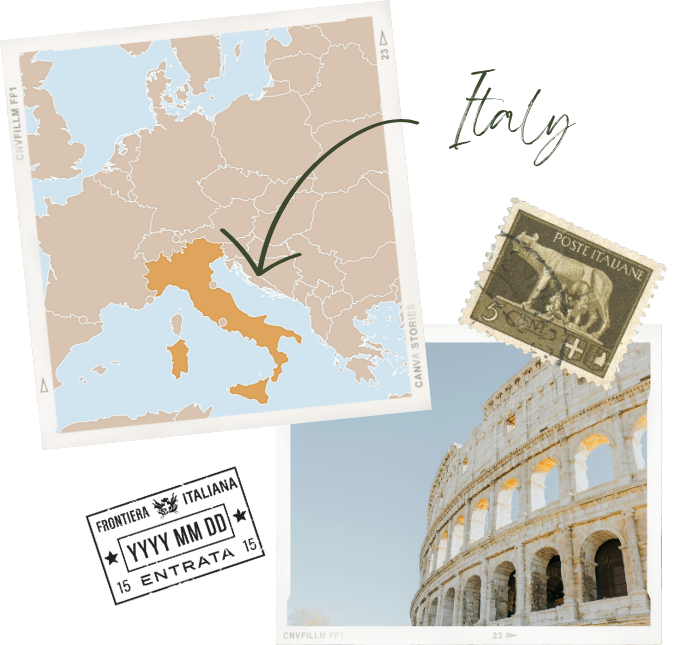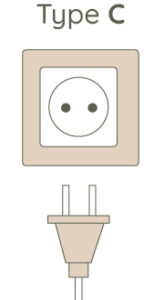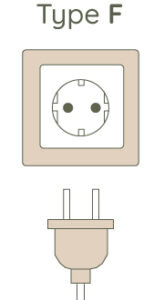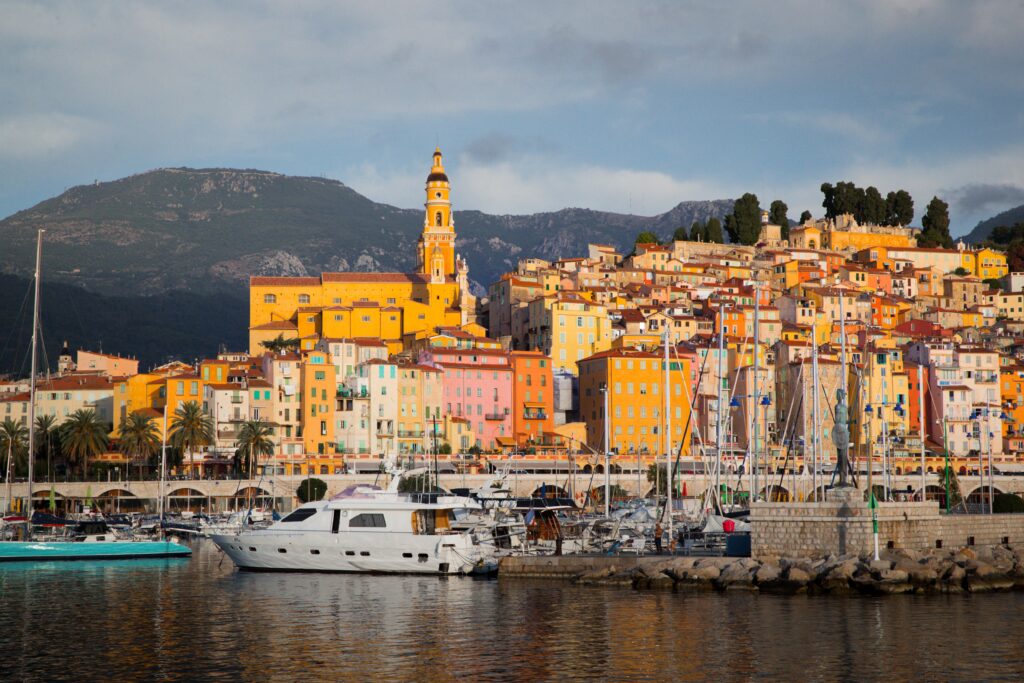VISIT Italy
Visiting world-famous monuments, hiking impressive mountains or tasting amazing gastronomy are only a few examples of how to appreciate Italian’s dolce vita.
Currency
€ - Euro (1€ ≃ 1,05$ ≃0,86£)
POPULATION
59 millions
MAIN LANGUAGE
Italian
AREA
301,230 km²
TIME ZONE
UTC+1 / UTC+2
FLAG
🇮🇹


WINDOW SHOP IN MILAN
The fashion capital of Italy is the birthplace of some famous luxury brands like Prada, Versace and Dolce & Gabbana.

HIKE IN THE DOLOMITES
Providing some of Europe's most breathtaking mountain scenery, this area has been listed as a UNESCO World Heritage Site.

RIDE A BOAT IN VENICE
The city's picturesque canals and iconic sights - Piazza San Marco, Doge’s Palace, and Rialto Bridge to name a few - live up to all expectations.

VISIT THE CINQUE TERRE
A collection of five historic fishing towns - Monterosso, Manarola, Corniglia, Vernazza and Riomaggiore - situated high on the Italian Riviera.

EXPLORE ROME
Rome has countless sights to see, the usual suspects being the Colosseum, the Roman Forum, Palatine Hill, and Trevi Fountain.
Pick an Italian destination

Rome
Capital of Italy, an open-air museum of ancient ruins and Renaissance art.

Milan
Fashion and design capital of Italy, with impressive cathedrals, galleries, and shopping.

Dolomites
Stunning Alpine range in northern Italy, perfect for hiking, skiing, and dramatic scenery.

Venice
Unique canal city built on water, famous for gondolas and timeless charm.

Cinque Terre
Five colorful cliffside villages along the Ligurian coast, linked by trails and sea views.
Prepare your trip to Italy
💡 Why visit Italy?
Italy is a treasure trove of art, architecture, and culinary delights. From the ancient ruins of Rome and the canals of Venice to the rolling vineyards of Tuscany and the dramatic coastline of the Amalfi Coast, the country offers an unparalleled mix of history, beauty, and lifestyle. With world-class museums, charming towns, and mouthwatering cuisine, Italy captivates all who visit.
🪪 Do I need a visa to visit Italy?
Italy is part of the Schengen area. Citizens of the EU, USA, Canada, Australia, and many other countries can enter visa-free for up to 90 days within a 180-day period. However, some nationalities do require a visa. It’s best to check with the nearest Italian embassy or consulate for the most up-to-date information specific to your situation.
IMPORTANT NOTE: The information below is provided merely as an indication and applies for short-term tourism visa purposes only. Before your trip to Italy, or if you are planning to come to Italy for another purpose (work, studies, …), check the official information on the European Commission website’s page about Schengen visa application: https://www.home-affairs.ec.europa.eu/
⏳ Visa-free but limited to maximum 90 days for a period of 180 days if you are a citizen of one of the following countries: Albania; Andorra; Antigua and Barbuda; Argentina; Australia; Austria; Bahamas; Barbados; Belgium; Bosnia and Herzegovina; Brazil; Brunei; Bulgaria; Canada; Chile; Colombia; Costa Rica; Croatia; Czechia; Denmark; Dominica; El Salvador; Estonia; Finland; France; Georgia; Germany; Greece; Grenada; Guatemala; Honduras; Hong Kong; Hungary; Iceland; Israel; Italy; Japan; Kiribati; Kosovo; Latvia; Liechtenstein; Lithuania; Luxembourg; Macau; Malaysia; Malta; Marshall Islands; Mauritius; Mexico; Micronesia; Moldova; Monaco; Montenegro; Netherlands; New-Zealand; Nicaragua; North Macedonia; Norway; Palau; Panama; Paraguay; Peru; Poland; Portugal; Romania; Saint Kitts and Nevis; Saint Lucia; Saint Vincent and the Grenadines; Samoa; San Marino; Serbia; Seychelles; Singapore; Slovakia; Slovenia; Solomon islands; South Korea; Spain; Sweden; Switzerland; Taiwan; Timor-Leste; Tonga; Trinidad and Tobago; Tuvalu; Ukraine; United Arab Emirates; United Kingdom; United States of America; Uruguay; Vatican; Venezuela
🛂 Visa required if you are a citizen of one of the following countries: Afghanistan; Algeria; Angola; Armenia; Azerbaijan; Bahrain; Bangladesh; Belarus; Belize; Benin; Bhutan; Bolivia; Botswana; Burkina Faso; Burundi; Cambodia; Cameroon; Cape Verde; Central African Republic; Chad; China; Comoros; Congo; Congo (Dem. Rep); Cote d’Ivoire (Ivory Coast); Cuba; Djibouti; Dominican Republic; Ecuador; Egypt; Equatorial Guinea; Eritrea; Eswatini; Ethiopia; Fiji; Gabon; Gambia; Ghana; Guinea; Guinea-Bissau; Guyana; Haiti; India; Indonesia; Iran; Iraq; Jamaica; Jordan; Kazakhstan; Kenya; Kuwait; Kyrgyzstan; Laos; Lebanon; Lesotho; Liberia; Libya; Madagascar; Malawi; Maldives; Mali; Mauritania; Mongolia; Morocco; Mozambique; Myanmar; Namibia; Nauru; Nepal; Niger; Nigeria; North Korea; Oman; Pakistan; Palestine; Papua New Guinea; Philippines; Qatar; Russia; Rwanda; Sao Tome and Principe; Saudi Arabia; Senegal; Sierra Leone; Somalia; South Africa; South Sudan; Sri Lanka; Sudan; Suriname; Syria; Tajikistan; Tanzania; Thailand; Togo; Tunisia; Turkey; Turkmenistan; Uganda; Uzbekistan; Vanuatu; Vietnam; Yemen; Zambia; Zimbabwe
⛅ When is the best time to visit Italy?
❄️ December – February: Winter is ideal for city breaks and ski trips in the Alps or Dolomites. Rome and Florence are quieter, with fewer tourists. Temperatures vary greatly: northern cities can drop to 0°C (32°F), while the south remains milder.
🌱 March – May: Spring is one of the best times to visit, with pleasant temperatures, blooming landscapes, and fewer crowds. It’s perfect for exploring historic cities and countryside regions like Tuscany or Umbria.
☀️ June – August: Summer is hot and lively, especially in July and August. Temperatures range from 25°C (77°F) to 35°C (95°F), particularly in central and southern Italy. Coastal areas and islands are popular but can get crowded.
🍂 September – November: Autumn brings milder weather, colorful vineyards, and harvest festivals. It’s a fantastic time for food and wine lovers, especially in regions like Piedmont and Emilia-Romagna.
🚉 How to get around Italy?
Italy has an extensive and efficient transport network:
🚌 Buses: Regional and long-distance buses connect towns and rural areas. Companies like Flixbus and Itabus serve major cities at affordable prices.
🚂 Trains: Italy’s train system is excellent. High-speed trains (Frecciarossa, Italo) connect major cities like Rome, Florence, Milan, and Naples. Regional trains are slower but serve smaller towns and scenic routes.
🚗 Car Rental: Renting a car is a good option for exploring rural areas, especially in Tuscany, Sicily, and the Dolomites. Be aware of ZTL zones (restricted traffic areas) in cities. An International Driving Permit (IDP) may be required if your license is not in Latin script.
💳 Can I use bank cards or cash for payments in Italy?
Cards are widely accepted in Italy, especially Visa and Mastercard. However, smaller shops, markets, and rural establishments may prefer cash, so carrying some euros is recommended. American Express is less commonly accepted.
🔌 What type of plugs and voltage does Italy use?
Italy Italy uses plug types C and F, both with two round pins. The standard voltage is 230V and the frequency is 50Hz.


If needed, you can order an universal travel plug adapter here.
🪙 Is tipping customary in Italy?
Tipping is not mandatory but appreciated. In restaurants, service is often included (check for “coperto” on the bill), but rounding up or leaving a small tip (5-10%) is common. Tipping in cafés or for taxis is optional.
🥛 Is it safe to drink tap water in Italy?
Tap water is safe to drink throughout Italy. Also, public fountains in cities like Rome often provide clean drinking water.
📅 When are public holidays and store closing days in Italy?
In Italy, some stores are closed on Sundays. There are 10 national public holidays in Italy:
- New Year’s Day (January 01)
- Epiphany (January 06)
- Easter Monday (date varies)
- Liberation Day (April 25)
- Labour Day (May 01)
- Republic Day (June 02)
- Assumption Day (August 15)
- All Saints’ Day (November 01)
- Immaculate Conception (December 08)
- Christmas Day (December 25)
On these days, most businesses and offices will be closed, and many attractions may be shut or have limited opening hours.
🚦 What are the speed limits in Italy?
In Italy, traffic drives on the right-hand side of the road. The main speed limits are as follows:
- 50 kph / 30 mph in urban areas
- 90 kph / 56 mph on secondary roads
- 110 kph / 68 mph on main roads
- 130 kph / 81 mph on motorways
During adverse weather (rain, fog, etc.), the speed limits are lowered.
💬 What are some basic Italian words I should know?
- Hello (informal) = Ciao
- Good day = Buongiorno
- Goodbye = Arrivederci
- Yes = Sì
- No = No
- Thank you = Grazie
- Please = Per favore
- You’re welcome = Prego
- Excuse me = Mi scusi
- Day = Giorno
- Night = Notte
- Good evening = Buonasera
- Goodnight = Buonanotte
- Mister = Signore
- Ma’am = Signora
- Street = Strada
- Road = Via
💡 Tip: With the GoogleTranslate app, you can download the Italian language to use it even offline!
🛡️ Is it safe to travel in Italy?
Italy is generally a safe country to travel in. Most visits are trouble-free, though petty theft such as pickpocketing can occur in busy tourist areas. Use common-sense precautions:
Secure Your Belongings: Be particularly mindful in places like Rome, Naples, and Florence.
Emergency Numbers: Dial 112 for police, ambulance, or fire services anywhere in Italy.








